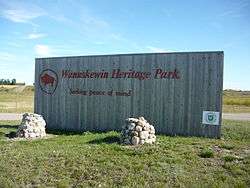Wanuskewin Heritage Park
| Wanuskewin Heritage Park | |
|---|---|
|
Wanuskewin Heritage Park | |
| Type | Operates as Authority |
| Location | Corman Park No. 344, near Saskatoon, Saskatchewan |
| Created | June 27, 1992 |
| Operated by |
Wanuskewin Indian Heritage Incorporated Wanuskewin Heritage Park Authority |
| Status | Open all year |
| Official name | Wanuskewin National Historic Site of Canada |
| Designated | 1986 |
Wanuskewin Heritage Park is a non-profit cultural and historical centre of the First Nations. (In the Cree language: ᐋᐧᓇᐢᑫᐃᐧᐣ / wânaskêwin means, "being at peace with oneself".) The site is a National Historic Site of Canada due to the importance of its archaeological resources representing nearly 6000 years of the history of the Northern Plains peoples.[1] In 2016, it was announced that Wanuskewin intends to seek UNESCO World Heritage designation,[2] which would make it the first World Heritage Site in Saskatchewan.
Background
The Saskatchewan Wanuskewin Indian Heritage Incorporated (WIHI) organization was established to present the interests of regional first nations in planning the park. The Wanuskewin Heritage Park Authority (WHPA) is in turn a 12 member organization responsible for the operation of the park. The WHPA board has representation from the first nations community, Government of Canada, Province of Saskatchewan, City of Saskatoon, University of Saskatchewan and Meewasin Valley Authority and the Friends of Wanuskewin.[3]
For more than 6,000 years people have gathered at this place. The nomadic tribes who roamed the Northern Plains came to hunt bison, gather food and herbs, and to find shelter from the winter winds. Some of the sites uncovered date back thousands of years. Wanuskewin is also the site of an arrangement of boulders called a medicine wheel, of which fewer than 100 remain on the northern plains.
Wanuskewin Heritage Park is located near the west bank of the South Saskatchewan River, just three kilometers north of Saskatoon, Saskatchewan. Within its 240 hectares (about 600 acres) there are 19 sites that represent the active and historical society of Northern Plains Peoples composed of Cree, Assiniboine, Saulteaux, Atsina, Dakota, and Blackfoot. On site there are summer and winter camp sites, bison kill sites, tipi rings, and artifacts such as pottery fragments, plant seeds, projectile points, egg shells and animal bones, all within a compact area.
Wanuskewin Heritage Park officially opened in June 1992; however scientific investigations in the area began in the early 1930s. Today, the University of Saskatchewan manages an archaeological research program at Wanuskewin with active archaeological digs. The Park was designated a Provincial Heritage Property in 1984, the only such site in Saskatchewan featuring prehistoric artifacts. It was named a National Historic Site in 1986. The following year Queen Elizabeth II unveiled a dedication plaque. In 2001, Prince Charles, was named Pisimwa Kamiwohkitahpamikohk, or, “the sun looks at him in a good way”, by an elder in a ceremony at Wanuskewin.
Wanuskewin's mission is to operate, on a sustainable basis, a Heritage Park under the leadership and guidance of First Nations people that contributes to increasing public awareness, understanding and appreciation of the cultural legacy of the Northern Plains First Nations people.
During the peak summer season about 40–45 people are employed at the park. The place serves as:
- a tourist attraction,
- human resource development agency
- scientific, cultural and educational authority
- Gathering place for present day spiritual uses such a Sweats, Pipe Ceremonies and more

References
External links
- Wanuskewin Heritage Park
- Significance of Treaties Reaffirmed Through Historic Royal Visit (2001)
- Award Winner Receives Royal Treatment (2003)
Coordinates: 52°13′25″N 106°35′42″W / 52.22361°N 106.59500°W
